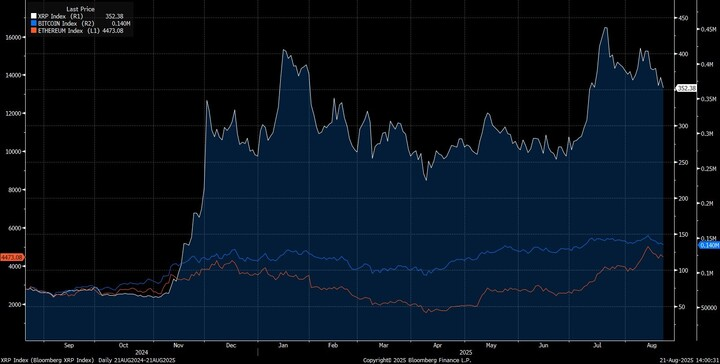
Bitcoin Treasury Companies: A Simple Idea That Could Reshape Corporate Finance
Plain English- guide to companies that use public markets to accumulate Bitcoin — and how ETFs can change the math.
Bitcoin treasury companies rest on a single, clear idea: use the reach of public markets to gather more of a scarce digital asset.
Instead of treating Bitcoin as a side bet, these firms make it central to how they allocate capital. If Bitcoin’s share of global wealth keeps growing from today’s small base, this straightforward model could matter a lot.
What’s new isn’t the technology—it’s the vehicle. Many investors want Bitcoin’s scarcity alongside audited accounts, board oversight, and clear disclosures. A treasury company bridges that gap: a listed stock built to accumulate and safeguard a growing reserve. It echoes earlier eras when investors used public vehicles to gain exposure to gold.
“Silver is a commodity that makes bad money… Gold is a commodity that makes better money. Bitcoin is a commodity that makes the best money because the stock-to-flow ratio is infinite. In essence, it’s 21 million. We know where it ends. It’s completely capped, completely scarce.”
— Michael J. Saylor, The Investor’s Podcast Network — Bitcoin Fundamentals, “Michael Saylor’s Deep Dive on Bitcoin Energy Misconceptions,” October 11, 2022
Read through that lens—Bitcoin as a monetary commodity—and the boardroom interest makes sense. A company that can reliably turn public-market funding into more coins, and protect them, has a simple mission and a simple scorecard: protect the base, expand the holdings, and steadily raise the amount of Bitcoin behind each share.

Why now
Three forces line up. First, supply is fixed at 21 million, so ownership is a matter of who accumulates and who holds. Second, acceptance has widened: many investors want access but prefer a familiar format to self-custody- or a pure fund. Third, public markets provide OnDemand- finance. A treasury company can sell small amounts of stock through an aftermarket- program, issue bonds that later convert into shares, or raise patient capital with preferred stock. Proceeds buy Bitcoin, holdings are anticipated to grow, and clear reporting helps keeps everyone aligned.
“I do believe the role of crypto is digitizing gold in many ways.”
— Larry Fink, CEO, BlackRock, July 5, 202
“Some like bitcoin, and that’s the only one I’m gonna say… my predecessors and others have said, they’re a commodity.”
— Gary Gensler, Chair, U.S. SEC, June 27, 2022
“Really almost no one uses bitcoin for payments… it’s a store of value, a speculative store of value, like gold.”
— Jerome H. Powell, Chair, U.S. Federal Reserve, July 10–11, 2019
“…the court re-affirmed that both Bitcoin and Ether are commodities under the Commodity Exchange Act.”
— Rostin Behnam, Chair, U.S. CFTC, July 10, 2024
How the model works
The flywheel is simple. The company raises capital; it buys Bitcoin; the larger holdings, if well managed and clearly disclosed, supports the equity’s appeal, which makes the next raise easier. Done with discipline, the key metric—coins per share—rises across full cycles, not just from quarter to quarter. When that number is climbing, the model is doing its job.
“MicroStrategy has adopted bitcoin as its primary treasury reserve asset.”
— Company press release, August 11, 2020
Financing, without the jargon
Preferred stock provides long-term capital with a stated dividend and no fixed maturity—steady funding that can support buy--and---hold accumulation. Convertible bonds start as plain borrowing but include the right for holders to swap into shares later; that option typically lowers interest costs today and shifts dilution to better times. Straight bonds are the simplest: predictable payments sized so the operating business can service interest even in a deep slump. There’s no need for derivatives or pledging coins as collateral. The aim is flexible, durable funding.
“Access to capital is the lifeblood of any compounding strategy.”
— Howard Marks (paraphrasing the principle), Oaktree Capital, 2012
What makes these companies different
They are intentionally tied to Bitcoin’s fortunes. In upswings, shares can outrun the coin itself as investors anticipate future purchases and a bigger stack. In downswings, the linkage cuts the other way. The better teams plan for both: cash cushions big enough to avoid forced selling, maturities that don’t bunch up, and clear rules for when to raise and when to wait.
“The best profit maximizing- strategy is to own the fastest horse… if I am forced to forecast, my bet is it will be Bitcoin.”
— Paul Tudor Jones, CNBC, May 11, 2020
What ETFs changed
Timeline: U.S. spot Bitcoin ETFs were approved in January 2024 and began trading shortly thereafter.1
Before those ETFs, many investors used proxies—treasury companies, miners, or closed end trusts—because they were the easiest way to get exposure, and some traded at premiums. With ETFs, that scarcity largely disappeared-. Investors can now get:
- Direct coin exposure via a simple ticker.
- Intraday liquidity with tight tracking.
- Single or low -double-digit -basis point- fees.
- And none of the corporate execution, dilution, or governance risk of a listed company.
ETFs didn’t make treasury companies obsolete, but they raised the bar. To justify a lasting premium over their coin stack, these firms must do what an ETF cannot: steadily increase the per share- BTC backing through disciplined capital raises, durable operating cash flows that buy more Bitcoin over time, or structural advantages (tax/accounting) that enhance long run- accumulation. Absent that, fair value is at or near NAV, with any premiums more likely to be temporary.
The leverage effect (in brief)
Spot ETFs also introduced clean, visible leverage: shares can be margined, and basis trades (long ETF/spot versus short futures) are straightforward—inside a rulebound, -daily marked system. Swings can still amplify, but the leverage is transparent and collateralized. For treasury companies, easier ETF leverage lowers the case for a persistent premium. To stand out, they must deliver what ETFs cannot: steady, -low drama- growth in per share- BTC across cycles.
Market structure as a catalyst
Market structure isn’t just plumbing; it can drive flows. When access gets cheaper, cleaner, and safer, more capital tends to show up. That can lift prices in the short run and stabilize ownership in the long run. In an ETF world, the edge for treasury companies isn’t access—it’s execution. Keep the balance sheet strong, raise on good terms, and add to the per-share reserve.
Skeptic’s corner: Why a premium may be undeserved (Jim Chanos’s view)
Short seller- Jim Chanos argues that a Bitcoin treasury wrapper shouldn’t command value above the coins it holds. His case is straightforward: investors who want bitcoin can buy it directly (or via low fee ETFs); paying extra for a listed company adds dilution, execution, and governance risks. As more companies copy the model, any -first mover- scarcity premium should fade, and obvious premiums invite arbitrage (short the stock, buy the coins).
“This is, of course, complete financial gibberish. Mr. Saylor wants you to value his business based not only on the net value of his Bitcoin holdings (NAV) at market, but additionally with a multiple on the change in that NAV…”
— Jim Chanos, post on X and Bloomberg interview, June 11–12, 2025
In plain English, Chanos’s point is that a treasury company doesn’t create new bitcoin or a durable moat simply by holding coins. Unless the structure reliably adds to the per share- reserve without undue risk, the equity should trade at or below the value of the underlying holdings. Premiums can appear in exuberant markets, but his view is that they rarely last once cheaper, simpler alternatives exist, and arbitrage capital shows up.
The risks, told straight
- Market drawdowns. Bitcoin can fall 30–60% for long stretches; issuing into weakness dilutes and stalls the per share- reserve, and forced sales reset the strategy at poor prices.
- Financing windows. ATMs/converts/preferreds work when markets are open; in stress, spreads widen, coupons jump, equity premiums vanish, and maturities that bunch become refinancing cliffs.
- Premium/discount swings. Premiums can disappear in a day; discounts can trap capital and sour sentiment even when the holdings are intact, especially when ETFs offer near par- exposure.
- Operational/custody. Key mismanagement, weak segregation of duties, or custodian failure can turn a small error into permanent loss; recovery is slow even with insurance.
- Accounting & optics. Fair value- marks push price moves through EPS—useful transparency, but noisy; some investors may read volatility as business instability.
- ETF competition. Low fee spot ETFs provide clean, intraday exposure; unless -per share- BTC rises steadily through cycles, paying a persistent premium for a listed company is hard to justify.
Mitigations (in brief): Maintain 6–12 months of runway with no market access; ladder maturities and avoid bunching; prefile a shelf to raise only into strength; avoid pledging coins; enforce boring controls (MPC/cold storage, dual approvals); report plainly on coins held, -per share- BTC, liquidity runway, and headroom.
A balanced view
You don’t need the rosiest forecast to see why the structure has legs. A scarce asset with growing acceptance meets a listed company that can raise money cleanly and report like any other business. The playbook is discipline, not wizardry: protect the base, add to the stack when terms are good, and communicate in plain English.
At the same time, this isn’t a free lunch. Spot ETFs now provide cheap, convenient access; that’s the baseline. For an equity wrapper to deserve more than the value of its coin stack, it must consistently increase per share- BTC and prove it can do so across different market regimes:
- Thrive: Adoption rises, and financing windows are open. Issue into strength, extend runway, and let the per share- reserve climb steadily.
- Muddle: Bitcoin trades sideways. Lean on operating cash flow, small opportunistic raises, and cost discipline; avoid issuance that doesn’t improve per share- BTC.
- Stress: Deep drawdown and tight markets. Pause issuance, defend the liquidity floor, avoid pledging coins, and wait for better terms—survival is the edge.
Judge these companies by behavior, not branding: how they raise, when they pause, how they disclose, and whether per share- holdings keep trending higher without hidden tail risks.
“Bitcoin is one hell of an invention.”
— Ray Dalio, Bridgewater Associates essay, January 28, 2021
Bottom line
Bitcoin treasury companies turn market access into ownership of a limited asset. In good times, they sprint; in tough times, they endure. If you watch only one number, make it coins per share—how quickly, and how safely, it climbs. Everything else is commentary.
Used alongside spot Bitcoin ETFs, the structure can be a compelling combination. ETFs provide the low-cost, -high liquidity- core with tight tracking and simple operations. Well-run- treasury companies can then serve as a targeted satellite, aiming to outperform through disciplined capital raises and steady per share BTC growth. Put together, a core--and---satellite approach captures the best of both worlds: clean access and transparency from the ETF, plus selective upside from a focused corporate allocator—without turning the portfolio into a trading shop.


I'm Joshua, a financial advisor from Reno, Nevada. As someone who co-founded and built a trust company and investment advisory firm from the ground up, I’m passionate about sharing the lessons I've learned on my financial journey of 30+ years to guide and empower clients to secure their financial futures. Using active macroeconomic quantitative and tax avoidance strategies, I mitigate risk and help families achieve lasting financial independence, acting as guardians for future generations. Trust, consistency, and accessibility are at the heart of all my long-lasting client relationships.

Joshua Barone is an investment advisor representative with Savvy Advisors, Inc. (“Savvy Advisors”). Savvy Advisors is an SEC registered investment advisor. Material prepared herein has been created for informational purposes only and should not be considered investment advice or a recommendation. Information was obtained from sources believed to be reliable but was not verified for accuracy. All investments involve risk, including loss or principal investment.
Ancora West Advisors, LLC dba Universal Value Advisors (“UVA”) is an investment advisor firm registered with the Securities and Exchange Commission. Savvy Advisors, Inc. (“Savvy Advisors”) is also an investment advisor firm registered with the SEC. UVA and Savvy are not affiliated or related.
Material prepared herein has been created for informational purposes only and should not be considered investment advice or a recommendation. Information was obtained from sources believed to be reliable but was not verified for accuracy. All investments involve risk, including loss of principal. Alternative investments and private placements involve a high degree of risk and can be illiquid due to restrictions on transfer and lack of a secondary trading market. They can be highly leveraged, speculative and volatile, and an investor could lose all or a substantial amount of an investment. Alternative investments may lack transparency as to share price, valuation and portfolio holdings. Prospective investors are advised that investment in a private fund or alternative investment strategy is appropriate only for persons of adequate financial means who have no need for liquidity with respect to their investment and who can bear the economic risk, including the possible complete loss, of their investment. All advisory services are offered through Savvy Advisors, Inc., an investment advisor registered with the Securities and Exchange Commission (“SEC”).
Reference:






